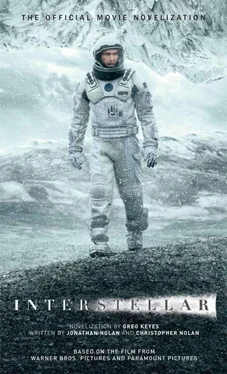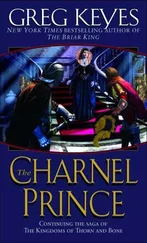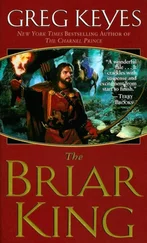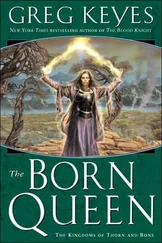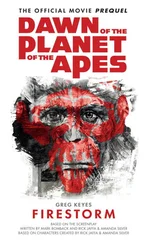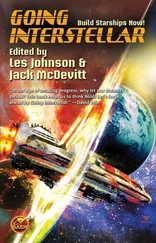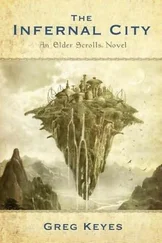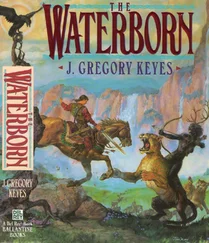Except a wormhole was better than that. It was a tunnel that just cut through all of that bothersome distance separating one place from another. And you did it in a fraction of the travel time. Relativity predicted wormholes, he remembered, but no one had ever seen one. They remained in the realm of theory.
Or so he’d thought. Yet here he was looking at one.
“Where does it lead?” Cooper asked.
“Another galaxy,” Romilly said.
Another galaxy? Cooper tried to bend that through his mind. Those distorted stars didn’t belong to Earth’s sky, or to the sky of any planet in the Milky Way. That, at least, was what Romilly was claiming. On one level, the very idea seemed preposterous. Yet these people seemed very serious about it indeed.
And there was something else. Something he remembered from his studies, back in the day.
“A wormhole isn’t a naturally occurring phenomenon,” Cooper said.
It was Dr. Brand who responded.
“Someone placed it there,” she agreed, trying to suppress a smile, her dark eyes challenging him to believe her.
“‘They,’” he said.
She nodded. “And whoever ‘they’ are, they appear to be looking out for us,” she said. “That wormhole lets us travel to other stars. It came along right as we needed it.”
“They’ve put potentially habitable worlds within our reach,” Doyle put in, excitement tangible in his voice. “Twelve, in fact, judging from our initial probes.”
“You sent probes into it?” Cooper asked.
“We sent people into it,” Professor Brand said. “Ten years ago.”
“The Lazarus missions,” Cooper guessed.
Professor Brand rose and gestured at the walls of the conference room, where twelve portraits hung. Cooper had noticed them before, but hadn’t studied them in detail.
They all were of astronauts, garbed in white spacesuits, sans masks, with the American flag and NASA logo on their shoulders. He had assumed the portraits dated to decades ago, but now he realized he didn’t recognize any of their faces. These were astronauts he could not name.
“Twelve possible worlds,” the professor said. “Twelve Ranger launches carrying the bravest humans ever to live, led by the remarkable Dr. Mann.”
Doyle picked up from there. In contrast with Romilly, Doyle had a sort of focused intensity.
“Each person’s landing pod had sufficient life support for two years,” he explained, “but they could use hibernation to stretch that, making observations on organics over a decade or more. Their mission was to assess their world, and if it was showing promise, send a signal, bed down for a long nap, and wait to be rescued.”
Cooper tried to imagine that. Alone, inconceivably far away from home, gambling everything on finding one habitable world out of twelve.
“And if their world didn’t show promise?” Cooper asked.
“Hence the bravery,” Doyle replied.
“Because you don’t have the resources to visit all twelve,” Cooper said.
“No,” Doyle confirmed. “Data transmission back through the wormhole is rudimentary—simple binary ‘pings’ on an annual basis, to give some clue as to which worlds have potential.” He paused, then added, “One system shows promise.”
“One?” Cooper said. “Kind of a long shot.”
Doyle shook his head, and his blue eyes flashed confidence.
“One system with three potential worlds,” Dr. Brand said. “No long shot.”
Cooper paused a moment to let it sink in. Three worlds, each—or all—offering potential new homes. Hope for his children and grandchildren. But if this ship, this Endurance was the only remaining deep-space vessel…
“So if we find a new home,” he asked, “what then?”
Professor Brand shot him an approving look.
“That’s the long shot,” he said. “There’s plan A, and there’s plan B. Did you notice anything strange about the launch chamber?”
* * *
The first time Cooper had been in the launch chamber, all he had been able to see was the rocket boosters and the Rangers perched upon it. Sure, he had off-handedly noticed that the chamber was a little bigger than it needed to be. But now, as he really studied it, he realized it was huge . Mind-bogglingly so.
It was shaped and proportioned something like a traditional grain silo, but if it was scaled down to the size of a grain silo, the Rangers and their boosters would become little more than largish models. The actual circumference of the upright cylinder looked to be as much as a third of a mile.
Hell, it might be more.
Though that was unusual, it wasn’t really the strangest part—not by far. The walls of the vast cylinder weren’t smooth, the way a normal launch silo would be. Normally, a silo’s main function was to shield the rest of the compound from a launch or—in the worst-case scenario—an explosion. So there would be no protuberances.
High above where he stood, several odd structures had been built onto the interior surface—were still being constructed, in fact. He couldn’t imagine what they were, though, or what their uses might be. Some almost looked like buildings, but jutting out at weird angles that would make them unusable.
Suddenly his perspective shifted, and dizzyingly. What if the structures actually were buildings? Houses, schools, other facilities. At the very thought, their purposes became clear. And yet, they were built along the curve, horizontal to the ground, useless…
On Earth , he thought. They’d be useless here on Earth. With a planetary gravity. But in space, with the vast cylinder spinning along its axis, “down” would be relative. The entire inner surface of the cylinder would become the ground on which folks would walk.
“This whole facility,” he began, still not quite believing what he was saying, “it’s a vehicle? A space station?”
“Both,” Professor Brand said. “We’ve been working on it—and others like it—for twenty-five years. Plan A.”
Cooper ran his gaze around the inside-out world that was still a work in progress. He’d seen designs for things like this, but they were meant to be built in space, not beneath the surface of a planet.
“How does it get off the Earth?” he asked. It seemed undoable. Even if there were thrusters powerful enough to push it into orbit, the entire structure would break up under the acceleration. No object so large could handle the force necessary to escape Earth’s pull.
“Those first gravitational anomalies changed everything,” Professor Brand explained. “Suddenly we knew that harnessing gravity was real. So I started working on the theory—and we started building this station.”
Cooper heard something in the professor’s tone.
“But you haven’t solved it yet,” he guessed, and the older man nodded grimly.
“That’s why there’s a plan B,” Dr. Brand said, her dark eyes studying him. Weighing him up, maybe? Trying to decide if he was worthy?
She motioned, and led Cooper to a nearby lab full of devices built for purposes he couldn’t even guess. They came to a stop in front of a vault made of glass and steel. It housed a series of movable shelves fronted by circular white seals. Dr. Brand grasped a handle on one and turned. The seal opened and she pulled out a cylindrical steel unit housing a multitude of glass vials.
Condensation sighed out from the now empty cavity, like a breath on a cold day.
“The problem is gravity,” she said. “How to get a viable amount of human life off this planet. This is one way. Plan B—a population bomb. Almost five thousand fertilized eggs, preserved in containers weighing in at under nine hundred kilos.”
Читать дальше
